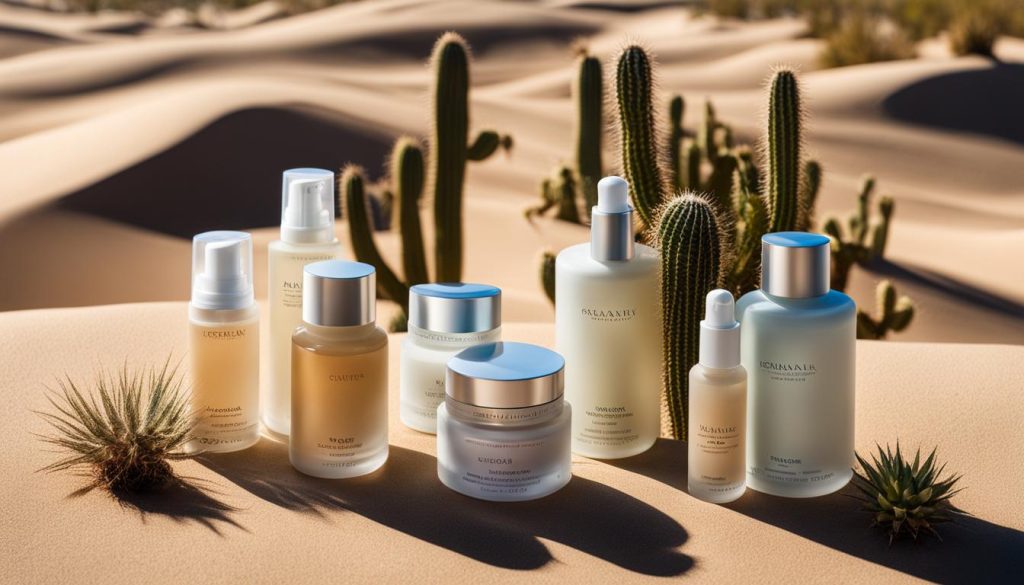As someone who has recently moved from a humid to a dry climate, like Arizona or New Mexico, I’ve had to navigate through my own skincare struggles—particularly with acne. The shift can lead to various skin issues such as dry skin, chapping, and that dehydrated feeling that practically screams for more protection and care. Having meticulously tailored my skincare regimen, I’ve found effective ways to maintain a healthy complexion. I learned that combatting skin dryness, itching, and the possible cracks that might come with a new arid environment is about taking proactive steps and adhering to skincare tips for dry climate acne.
Let me share the insights and strategies that have made this transition smoother and kept my skin feeling hydrated and clear.
Key Takeaways
- Transitioning to a dry climate requires a significant adjustment in skincare routines to avert dehydration.
- Implementing a humectant moisturizer daily is essential to maintaining moisture levels in the skin.
- Regular use of sunscreen protects against the harsh effects of UV rays, which can be more intense in dry, sunny regions.
- Integrating a humidifier into your home can help maintain a more skin-friendly environment.
- Be on the lookout for signs of climate-induced acne, like post-shower tightness and visible dry patches.
- Adapt your skincare practices, including the role of hydration, to adequately shield your skin against the unique challenges of a dry climate.
Understanding Your Skin’s Reaction to Dry Climates
Moving from a humid to a dry climate often comes with a host of skin changes, one of the most prominent being the occurrence of acne. This isn’t merely a cosmetic concern; it’s a sign that our skin is losing moisture and its natural protective barrier is weakening. My experience transitioning to a drier environment taught me valuable lessons on safeguarding my skin’s health, which I’m eager to share.
The Impact of Dry Weather on Acne-Prone Skin
In a dry climate, moisture evaporates from the skin more rapidly, which can lead to a reduction in the skin’s natural oils. These oils are essential for keeping our skin supple and defending against irritants that can cause skin breakouts in dry climates. Without adequate hydration, dead skin cells accumulate, clog pores, and give rise to acne. It’s a challenging cycle, but one that can be managed with proper care to prevent acne in a dry climate.
How Humidity Levels Affect Skin Health
The loss of humidity in the environment has a direct impact on the skin’s hydration levels. Living through seasons of low humidity showed me that a boost in my skincare routine was imperative. Implementing consistent and more intensive moisturizing practices helped me combat acne in dry weather, ensuring my skin stayed balanced despite the arid conditions.
Recognizing the Signs of Climate-Induced Acne
Recognizing the early signs of skin reactions to climate changes is crucial for immediate action. Sensations of tightness after cleansing, an increase in sensitivity or redness, and even a rough, ashy texture can all indicate the onset of skin changes in dry climates. By staying vigilant and adjusting my skincare regimen, I was able to minimize acne and maintain a healthy complexion. Here are my top skincare tips for dry climate:
- Hydrate often, both internally by drinking water and externally by using suitable moisturizers.
- Incorporate gentle, hydrating cleansers that don’t strip away essential oils.
- Avoiding harsh exfoliants that can exacerbate dryness and irritation.
- Apply a rich night cream to support skin repair while sleeping.
Transitioning to a dry climate does not have to spell disaster for your skin. With a careful approach and an understanding of your skin’s needs, you can keep it healthy and clear, no matter the weather outside.
Preventive Skincare Strategies for Dry Environments
Living in a place where the air is as dry as kindling, I’ve learned that maintaining a vigilant skincare regimen is key to preventing my skin from becoming as parched as the landscape. Hydration is the mantra I live by, both inside and out. To ensure my skin stays plump and dewy, I follow a strategic skincare routine that adapts to the needs of elevation skin care, where thin air can drain moisture faster than one might think.

My first line of defense is always a moisturizer that understands the challenge—it has to be potent enough for the harsh dryness but smart enough not to clog the pores. I lean towards products marketed as moisturizer for humid weather because they tend to strike the perfect balance between hydration and lightness. It’s counterintuitive, but these formulas often work wonders even when there’s not a drop of humidity in sight.
- Hydrating Serums: I boost my skincare regimen with hydrating serums that have glycerin, hyaluronic acid, and aloe vera. The magic is in their molecular makeup—these hydrating heroes can hold onto water like a lifeline, offering my skin a quenching relief.
- Intensive Hand Cream: It’s not just my face that feels the brunt; my hands often bear the telltale signs of a dry climate. An intensive hand cream is not negotiable. I look for a hand therapy that’s been formulated with skincare humid weather in mind, as they’re brimming with moisture-sealing ingredients.
- Overnight Restoration: Nighttime is when I give my skin an extra dose of care with an overnight face mask. These treatments create a barrier that locks in moisture, allowing my skin to repair and rejuvenate while I catch up on my beauty sleep.
- Vitamin Injections: If my skin is feeling particularly rebellious, I don’t hesitate to up my game with vitamin injections. These are the heavy artillery in my arsenal of hydration skin care, aimed at replenishing my skin’s lost nutrients.
I’m always fine-tuning my routine to align with the elevation skin care principles, learning that altitude can affect skin as much as climate. The combination of high altitude and dry air can cause the skin to lose moisture more rapidly, making attributes like persistence and adaptability not just useful, but necessary for healthy skin. Remember, preventive care is far simpler than trying to repair skin that’s already overexposed to the elements.
Moving from Humid to Dry Climate Acne: Tailoring Your Routine
When I transitioned to a desert climate, adjustments to my skincare routine were imperative to keep my skin hydrated and healthy. I discovered that the secret to combating the drying effects of this new environment lay in selecting the right products and revising my daily regimen—a challenge familiar to any skincare aficionado in arid regions or those used to skincare for humid climate. Below, I’ll share how I tailored my routine for my now home in the Rocky Mountain region, ensuring that my skin didn’t suffer in the process.
Adjusting Moisturizers for Optimal Hydration
As someone who values skin care in humid weather, I quickly realized the necessity of a gel-based moisturizer infused with natural oils in the drier climate. These not only seal in the moisture but do so without the unwelcome shine. The result? A comfortable, hydrated complexion I can depend on, whether I’m indoors with the heat cranked up or facing the fierce sun outside.
The Necessity of SPF in Arid Weather
My appreciation for SPF took on a new meaning under the intense sun characteristic of the desert climate. Hydrating sunscreens became my go-to, pulling double-duty both as a protective barrier against harmful UV rays and a daily moisturizer. This critical step in my skincare for desert climate is one I never skip, whether I’m out on a hike or simply running errands. The sun in these regions doesn’t discriminate, and neither does my dedication to sun protection.
Incorporating Serums for an Extra Hydration Boost
One tweak to my regimen was adding a quenching serum that caters to the unique demands of rocky mountain skin care. These magical elixirs offer an added layer of hydration that my skin drinks up eagerly, especially on days when the dry air seems unrelenting. This, combined with a soothing face mist I use throughout the day, helps to maintain that dewy look and feel, keeping skin tightness and dryness at bay.
- Choose lightweight, gel-based moisturizers with natural oils.
- Make SPF a non-negotiable part of your daily routine.
- Use serums rich in hydrating ingredients for an extra moisture surge.
- Keep a refreshing face mist on hand to revive your skin throughout the day.
My skin care for humid weather may have been perfect for a tropical paradise, but my current, personalized practice is proving to be just the right fit for my skin’s needs in this dryer, more demanding climate.
Solutions for Managing Acne in Dry Climate Conditions
My journey to mastering the control of acne doesn’t stop with just identifying the problem, but it’s in discovering actionable solutions that provide real relief. It’s essential to know that managing acne in a dry climate involves a strategic approach to skincare, where hydration is non-negotiable, and the selection of treatments is tailor-made for these conditions.
Hydrating Inside and Out: The Role of Water Intake
Proper hydration starts from within. I make it a point to increase my water intake, aiming for eight glasses a day, to ensure that my body—and by extension, my skin—stays sufficiently hydrated. The dry climate is unforgiving, but I’ve found that maintaining internal hydration is a cornerstone of managing acne in these conditions.
Selecting the Right Acne Treatments for Arid Regions
Adjusting my skincare routine for dry climate acne includes being selective about the products I use. I avoid treatments that over-dry the skin and instead choose options like Mountain Ice Eczema Cream, which hydrates while soothing inflamed skin. This approach minimizes irritation and promotes healthy skin balance, even amidst low humidity challenges.
Managing Oil Production Amidst Dry Air
Managing oil production is also critical. Rather than using harsh astringents, I stick to gentle, non-stripping cleansers and regularly incorporate a serum rich in hyaluronic acid into my regimen. By doing so, I’m able to support my skin’s moisture barrier, preventing the overproduction of oil that could lead to acne flare-ups.
- Ensuring I stay well-hydrated by monitoring my daily water intake
- Selecting acne treatments designed with arid conditions in mind, like Mountain Ice Eczema Cream
- Adjusting my skincare routine by incorporating products that support the skin’s natural barrier
By taking these steps, I’ve not only witnessed improvements in my skin’s appearance but also in its resilience against the dry climate’s harsh effects.
Conclusion
Moving from a humid to a dry climate presents unique challenges for my skin, particularly when it comes to preventing breakouts and maintaining a clear complexion. Based on my experience and research, adapting swiftly to a new atmosphere is paramount for keeping acne at bay. Indeed, a skincare routine for a dry climate demands a strategic approach, emphasizing hydrating practices and the right mix of products.
Adapting to a New Climate While Maintaining Acne-Free Skin
To successfully prevent breakouts when moving to a dry climate, I’ve learned that it’s not just what I apply on my skin that matters, but also what I put inside my body. Internal hydration by drinking plenty of water becomes my skin’s best friend in arid conditions. Simultaneously, I have come to value the protective benefits of SPF, which shields my skin from the harshness of UV rays that are often more intense in dry areas. Consistently using humectants and emollients ensures that moisture is drawn to my skin and locked in, providing the armor my skin needs against the dehydrating elements.
Learning how to treat acne in dry weather has also involved curbing the use of aggressive exfoliants that can exacerbate dryness and switching to gentler alternatives. Moreover, the addition of hydrating serums to my arsenal has become a daily ritual that helps bolster my skin’s resilience. Nightly, I rely on overnight hydrating treatments to work their magic as I sleep, ensuring that I wake up to a nourished and supple complexion. Overall, adapting to dry climate and acne means embracing a new set of skincare habits—ones that cater to a delicate balance of moisture, protection, and gentle care.
FAQ
How does moving from a humid to a dry climate affect acne?
Moving from a humid to a dry climate can exacerbate acne by causing the skin to produce more oil to compensate for the loss of moisture, leading to clogged pores and breakouts. This transition can also compromise the skin’s barrier function, making it more vulnerable to acne-causing bacteria.
Why is skin care different in a dry climate?
In a dry climate, skin is more prone to dehydration, which can result in dryness, irritation, and an increase in dead skin cells that can block pores. Therefore, skin care routines must focus on maintaining hydration and strengthening the skin’s protective barrier.
What are the signs of climate-induced acne?
Climate-induced acne may present as a sudden increase in breakouts, skin that feels unusually tight after cleansing, rough or ashy skin texture, increased redness or inflammation, visible cracks, and scaly patches. These symptoms may signal the need for special attention to hydration and gentle cleansing in your skin care routine.
What moisturizer should I use in humid weather?
In humid weather, it’s recommended to use a lightweight, gel-based moisturizer that doesn’t clog pores while offering sufficient hydration without the heavy feel that might promote sweating and contribute to breakouts.
How do I adjust my moisturizer for a dry climate?
For a dry climate, your moisturizer should be richer and more nourishing, ideally containing hyaluronic acid to attract moisture, and occlusive agents like shea butter or natural oils to seal in the hydration.
Is SPF necessary in a dry climate, and why?
Yes, SPF is necessary in a dry climate because UV radiation can exacerbate dryness and sun damage is a risk regardless of climate. A hydrating sunscreen formula can also act as a daily moisturizer while protecting against harmful rays.
How can serums boost hydration in a dry climate?
Serums can boost hydration by delivering concentrated active ingredients, like hyaluronic acid, glycerin, and vitamin E, which penetrate deeply to hydrate skin cells. These serums support the skin’s barrier and help it to retain moisture more effectively.
What role does water intake play in managing acne in a dry climate?
Water intake plays a crucial role in maintaining skin hydration from within, which is especially important in dry climates. Drinking enough water supports overall skin health and helps to flush out toxins that can contribute to acne.
How should I select acne treatments for arid regions?
Select acne treatments that are hydrating and non-irritating in arid regions. Products with hyaluronic acid, niacinamide, and gentle exfoliants like lactic acid can help manage acne without dehydrating the skin.
How do you manage oil production in dry weather?
To manage oil production in dry weather, use non-stripping cleansers, avoid over-exfoliation, and apply moisturizers that balance the skin’s natural oils. Look for ingredients like squalane and ceramides that support a healthy skin barrier without causing excess oiliness.
What adjustments should I make to my skincare routine when moving to a dry climate to prevent acne breakouts?
Adjust your skincare routine by reducing the use of harsh exfoliants, incorporating more hydrating products, and using a richer moisturizer. It is also vital to protect your skin from the sun using SPF and to maintain hydration by drinking plenty of water.
How can I treat acne in dry weather?
To treat acne in dry weather, focus on gentle cleansing, ensure adequate hydration, use a humidifier to add moisture to the air, and select acne treatments that are appropriate for a dry climate. Don’t forget to maintain a consistent skincare routine that is adjusted for the arid conditions.
What are the best skincare tips for adapting to a dry climate?
The best skincare tips for adapting to a dry climate include using a humidifier to add moisture to the air, applying a thicker moisturizer to lock in hydration, avoiding hot showers and harsh soaps, and using products with ingredients such as hyaluronic acid, glycerin, and aloe vera to maintain moisture levels.






